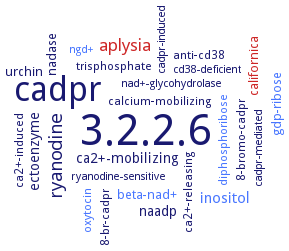3.2.2.6: ADP-ribosyl cyclase/cyclic ADP-ribose hydrolase
This is an abbreviated version!
For detailed information about ADP-ribosyl cyclase/cyclic ADP-ribose hydrolase, go to the full flat file.

Word Map on EC 3.2.2.6 
-
3.2.2.6
-
cadpr
-
ryanodine
-
aplysia
-
inositol
-
naadp
-
ectoenzyme
-
ca2+-mobilizing
-
californica
-
gdp-ribose
-
nadase
-
beta-nad+
-
urchin
-
diphosphoribose
-
calcium-mobilizing
-
8-br-cadpr
-
oxytocin
-
ca2+-releasing
-
anti-cd38
-
trisphosphate
-
8-bromo-cadpr
-
ca2+-induced
-
nad+-glycohydrolase
-
ngd+
-
ryanodine-sensitive
-
cd38-deficient
-
cadpr-mediated
-
cadpr-induced
- 3.2.2.6
-
cadpr
-
ryanodine
- aplysia
- inositol
-
naadp
-
ectoenzyme
-
ca2+-mobilizing
- californica
- gdp-ribose
- nadase
- beta-nad+
-
urchin
- diphosphoribose
-
calcium-mobilizing
-
8-br-cadpr
- oxytocin
-
ca2+-releasing
-
anti-cd38
-
trisphosphate
-
8-bromo-cadpr
-
ca2+-induced
- nad+-glycohydrolase
- ngd+
-
ryanodine-sensitive
-
cd38-deficient
-
cadpr-mediated
-
cadpr-induced
Reaction
Synonyms
ADP-ribosyl cyclase, ADPR cyclase, bCD38, CD38, CD38/NAD+ glycohydrolase, NAD(P) nucleosidase, NAD(P)+ glycohydrolase, NAD(P)+-glycohydrolase, NAD(P)-glycohydrolase, NAD(P)ase, NAD+ glycohydrolase, NADase, nicotinamide adenine dinucleotide (phosphate) glycohydrolase, nicotinamide adenine dinucleotide (phosphate) nucleosidase, nucleosidase, nicotinamide adenine dinucleotide (phosphate), triphosphopyridine nucleotidase
ECTree
Advanced search results
Engineering
Engineering on EC 3.2.2.6 - ADP-ribosyl cyclase/cyclic ADP-ribose hydrolase
Please wait a moment until all data is loaded. This message will disappear when all data is loaded.
D147A
site-directed mutagenesis, the mutant shows a decrease in activity compared to the wild-type enzyme
E138A
site-directed mutagenesis, the mutation causes a modest increase in the rate of NAD+ transformation which is proportional to its concentration. At 4.0 M, the rate increase is about 1.2fold and the formation of beta-1'-O-methyl ADP-ribose amounts to about 80% of the total reaction products. The observed selectivity in favor of methanolysis is similar to that of wild-type enzyme. The ADP-ribosyl cyclase activity of E138A mutant is more affected by the competing nucleophile, i.e. formation of ADP-ribose and cADPR are reduced by 75% and 90% respectively at 4.0 M methanol, the mutant shows an increase in ADP cyclization and higly reduced overall activity compared to the wild-type enzyme
E138Q
site-directed mutagenesis, in the presence of methanol, mutant E138Q efficiently catalyzes the formation of beta-1'-O-methyl ADP-ribose. But in contrast with mutant E138A, and like the wild-type enzyme, solvolysis does not affect the overall turnover rate of NAD+ indicating that the formation of the E.ADP-ribosyl intermediate is still rate limiting
E218A
site-directed mutagenesis, the mutant shows a decrease in activity compared to the wild-type enzyme
E218Q
K120A
site-directed mutagenesis, the mutant shows reduced activity compared to the wild-type enzyme
R216A
site-directed mutagenesis, the mutant shows reduced activity compared to the wild-type enzyme
S185A
site-directed mutagenesis, the mutant shows reduced activity compared to the wild-type enzyme
W118A
site-directed mutagenesis, the mutant shows a decrease of the catalytic rate compared to the wild-type enzyme
W118A/W181A
site-directed mutagenesis, the mutant shows a decrease of the catalytic rate which is 16fold lower than the product of the effects of the two single mutations
W118F
site-directed mutagenesis, the mutant shows a decrease in activity compared to the wild-type enzyme
W118H
site-directed mutagenesis, the mutant shows a decrease in activity compared to the wild-type enzyme
W168A
site-directed mutagenesis, the mutant shows reduced activity compared to the wild-type enzyme
W181A
site-directed mutagenesis, the mutant shows a decrease of the catalytic rate and a reduced sensitivity to nicotinamide inhibition compared to the wild-type enzyme
W181F
site-directed mutagenesis, the mutant shows a decrease in activity and an increase in ADP cyclization compared to the wild-type enzyme
E226D
E226Q
additional information
site-directed mutagenesis, catalytic site mutant, crystal structure analysis, almost inactive mutant
E218Q
site-directed mutagenesis, the mutant shows a decrease in activity compared to the wild-type enzyme
construction of CD38/NAD+ glycohydrolase truncated for the first 31 amino acids that encompass the transmembrane and short intracellular domains
additional information
-
construction of CD38/NAD+ glycohydrolase truncated for the first 31 amino acids that encompass the transmembrane and short intracellular domains


 results (
results ( results (
results ( top
top






